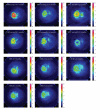Longitudinal Evaluation of Fatty Acid Metabolism in Normal and Spontaneously Hypertensive Rat Hearts with Dynamic MicroSPECT Imaging
- PMID: 21490736
- PMCID: PMC3072139
- DOI: 10.1155/2011/893129
Longitudinal Evaluation of Fatty Acid Metabolism in Normal and Spontaneously Hypertensive Rat Hearts with Dynamic MicroSPECT Imaging
Abstract
The goal of this project is to develop radionuclide molecular imaging technologies using a clinical pinhole SPECT/CT scanner to quantify changes in cardiac metabolism using the spontaneously hypertensive rat (SHR) as a model of hypertensive-related pathophysiology. This paper quantitatively compares fatty acid metabolism in hearts of SHR and Wistar-Kyoto normal rats as a function of age and thereby tracks physiological changes associated with the onset and progression of heart failure in the SHR model. The fatty acid analog, (123)I-labeled BMIPP, was used in longitudinal metabolic pinhole SPECT imaging studies performed every seven months for 21 months. The uniqueness of this project is the development of techniques for estimating the blood input function from projection data acquired by a slowly rotating camera that is imaging fast circulation and the quantification of the kinetics of (123)I-BMIPP by fitting compartmental models to the blood and tissue time-activity curves.
Figures








References
-
- Nohara R. Lipid metabolism in the heart: contribution of BMIPP to the diseased heart. Annals of Nuclear Medicine. 2001;15(5):403–409. - PubMed
-
- Opie LH. The Heart: Physiology and Metabolism. 2nd edition. New York, NY, USA: Raven Press; 1991.
-
- Neely JR, Morgan HE. Relationship between carbohydrate and lipid metabolism and the energy balance of heart muscle. Annual Review of Physiology. 1974;36:413–459. - PubMed
-
- Matsuo S, Nakamura Y, Takahashi M, Mitsunami K, Kinoshita M. Myocardial metabolic abnormalities in hypertrophic cardiomyopathy assessed by iodine-123-labeled beta-methyl-branched fatty acid myocardial scintigraphy and its relation to exercise-induced ischemia. Japanese Circulation Journal. 1998;62(3):167–172. - PubMed
-
- Okizaki A, Shuke N, Sato J, et al. A compartment model analysis for investigation of myocardial fatty acid metabolism in patients with hypertrophic cardiomyopathy. Nuclear Medicine Communications. 2007;28(9):726–735. - PubMed
Grants and funding
LinkOut - more resources
Full Text Sources

